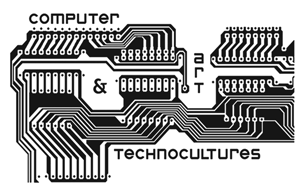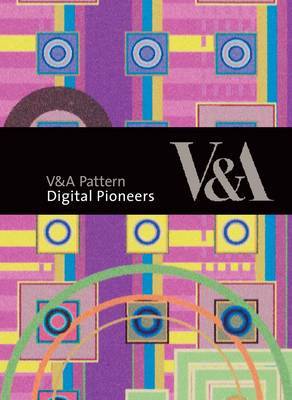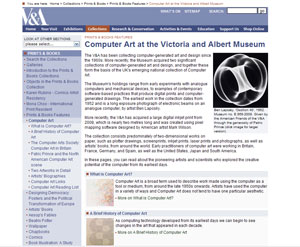|
|
|
|
|
|
|
|
|
||||||||
|
|
|
||||||||||||||
|
|
|
|
|
|
|
|
|||||||||
|
|
|
|
|
|
|
|
|||||||||
|
|
|
||||||||||||||
|
|
|
||||||||||||||
|
We will produce a collection of invited essays covering this seminal period of Computer Art. They will examine the trajectory of digital art and artists throughout the 1980s and develop the research directions produced by our examination of the Patric Prince Collection. This will be published to
accompany a V&A display showcasing the
evolution of Computer Art. Recent Outcomes August The project partners gave a series of presentations at ISEA Ruhr, marking the completion of the project. The panel session on 27 August was entitled Codifying history: the CAT Project examines the international trajectory of computer art 1975-2000. April
The Digital Pioneers display continues at the V&A until 25 April 2010. March Douglas Dodds is due to speak about Digital Pioneers on Resonance FM radio, on Tuesday 9 March between 8 and 9 p.m. It's on 104.4 FM and also online at http://resonancefm.com/ The Digital Pioneers display continues to receive favourable reviews, including one for Furtherfield. February
See here for details of our Symposium held at the British Computer Society on 3rd February 2010.
This was followed by Decoding the Digital, a two-day conference at the V&A on 4th-5th February. Many of the artists included in the Digital Pioneers display were able to attend, along with some of the artists whose work features in Decode.
Digital artists at the Decoding the Digital conference (Right to left) Frieder Nake, Roman Verostko, Manfred Mohr, Mark Wilson and James Faure Walker (who all feature in Digital Pioneers); plus Casey Reas and Karsten Schmidt ( who both feature in Decode). Photograph : Douglas Dodds. The conference received extensive coverage, including reviews of Day 1 and Day 2 by Eye Magazine. Honor Beddard also published an article for Eye's blog, entitled 20-20 digital hindsight: early adopters of computer art and design enter the V&A collections. December "Compellingly simple and made with rudimentary technology, much of the work in Digital Pioneers is astonishingly beautiful and seems both brave and prescient" - New York Times
The Digital Pioneers display opens at the V&A on 7 December, and closes on 25 April 2010. The following information is taken from the Museum's website:
Digital Pioneers
This display provides an overview of the first decades of the computer's history in art and design. It includes some of the earliest computer-generated works in the V&A's collections, many of which have never been exhibited in the UK before. From the 1960s until the early 1980s, digital pioneers worked directly with computer hardware and software to produce graphic images unlike anything that had gone before. Some artists went on to use increasingly sophisticated software packages, while others continued to work directly with the hardware itself. The display includes plotter drawings, screenprints, digital inkjet prints, photographs and animations, as well as important documentary material from the time. It features pioneers working in science and industry during the 1950s and 60s, such as Frieder Nake, Georg Nees and Herbert W. Franke. Artists who worked with the computer in the 1970s and 80s include Paul Brown, Harold Cohen, Manfred Mohr and Vera Molnar. The show also encompasses more recent works by James Faure Walker, Jean Pierre-Hébert, Roman Verostko and Mark Wilson. Digital Pioneers offers a historical context for contemporary digital practice, and is scheduled to coincide with the V&A exhibition Decode: Digital Design Sensations."
November The project partners announced that a symposium will be held at the British Computer Society on 3 February 2010. The symposium is entitled Ideas Before Their Time - Connecting the past and the present in Computer Art. For more details see the symposium page. Ideas Before Their Time is organised in conjunction with a two day conference entitled Decoding the Digital, to be held at the V&A on 4-5 February 2010. More details about this will be available soon. Douglas Dodds spoke at a seminar on 11 November, entitled Fear and Learning: Approaches to the Born-Digital Challenge in Art & Design Archives. His paper was called From analogue to digital: preserving early computer-generated art. The text is due to appear in the Art Libraries Journal in 2010. Douglas Dodds made a presentation on the V&A's research projects at a symposium organised by the Yale Center for British Art. The two-day event was held at the National Portrait Gallery and the Paul Mellon Centre. The presentation included a section on the Computer Art and Technocultures project. October The V&A launched a new version of its Search the Collections database, which now includes more than a million records for objects in the Museum's collections. The service also includes records for many computer-generated artworks. To see a selection, do a simple keyword search for computer art.
Roman Verostko visited the V&A and Birkbeck, where he also gave a presentation at a meeting of the Computer Arts Society. July
Digital Pioneers, by Honor Beddard and Douglas Dodds, was published by the V&A in July 2009. The book contains selected images from the Museum's computer art collections and is available from the V&A shop, Amazon and other good booksellers. The V&A also announced that Digital Pioneers, the display associated with the book and the project, will be held from 7 December 2009 to 23 May 2010. The display will be linked to a contemporary exhibition entitled Decode: Digital Design Sensations, from 8 December 2009 – 11 April 2010. For more details, see the Museum's press release, which includes the following description of the Digital Pioneers display: "Digital Pioneers Alongside Decode: Digital Design Sensations there will be a display in the Julie & Robert Breckman Prints and Drawings Gallery and Gallery 88a at the V&A on the history of digital design. Digital Pioneers will showcase some of the earliest computer-generated art and design drawn from the V&A’s recently acquired computer art collections and will include works by Frieder Nake, Georg Nees, Roman Verostko, and British artists Paul Brown and Harold Cohen. The display will explore the arrival of the computer in art and design practices across the globe and its impact on subsequent generations. It will include plotter drawings, screen prints, digital inkjet prints, photographs and early algorithmic works, as well as important documentary material from the time. The display will be open from 7 December 2009... Admission will be free." ------
Click here for a pdf of the press release, The MFA Computer Art Department at the School of Visual Arts (SVA) presented Technocultures: The History of Digital Art–A Conversation, on March 6 2009. The panel featured influential historical practitioners and researchers on digital art. Department Chair Bruce Wands moderated. The panel traced the history of digital art through vignettes and personal anecdotes of four pioneers: Kenneth Knowlton, Margot Lovejoy, Kenneth Snelson and Lillian Schwartz. They were joined by Jeremy Gardiner and Nick Lambert, who are working with Birkbeck College, University of London, and the Victoria and Albert Museum on a project called Technocultures. Click
here to view part 1 of the Technocultures panel Click
here to view part 2 of the Technocultures panel
. Click
here to view part 3 of the Technocultures panel
. Once again, the CAT Project would like to thank Bruce Wands and the SVA for staging this historic panel session in New York last March. ------ The EVA London 2009 Conference had a day
dedicated to Digital Art History and Practice. This was developed
by Nick Lambert as Programme Chair and featured Jeremy Gardiner
discussing his own digital art practice in the context of the
history of digital art. June The V&A website now includes a series of webpages about the Museum's computer art collections, at: http:///www.vam.ac.uk/computerart
The pages include an introduction to the subject, plus brief summaries for each decade, biographies of some of the major artists, and a glossary. Some individual artworks are already included in the V&A's "Search the Collections" service, and others will be added to the database in the coming months. ------ Francesca Franco became the Research Fellow at Birkbeck. May About 680 books from the Patric Prince Archive are now included in the National Art Library catalogue
For a complete list, do a "Name" search for Patric Prince Archive ------ Douglas Dodds visited St. Vincent Monastery in Latrobe, Pennsylvania, which holds early works by Roman Verostko. April April 3rd: Catherine Mason used images from the V&A's computer art collections in her presentation at the Personalised Surface symposium, held in the Museum's Sackler Centre. March March 20th:Jeremy Gardiner spoke at the Print in 3D symposium, held at the V&A. ------ March 6th: The panel 'Technocultures' was convened at the School of Visual Arts, New York, by Computer Department Chair Bruce Wands. The veteran computer artists Ken Knowlton, Margot Lovejoy, Lillian Schwartz and Kenneth Snelson discussed their life and works and answered questions from the floor. Jeremy Gardiner and Nick Lambert presented the work of CAT. March 5th: Jeremy Gardiner and Nick Lambert presented the work of CAT by invitation to graduate students at the Pratt Institute, New York. February Nick Lambert, Jeremy Gardiner and Seamus Malone interviewed David Em in southern California. For the full text, see David Em interview. Many thanks to David for his time and his extensive recollections. 2008 November Freider Nake visited the V&A to view works in the collection. Barbara Nessim also came to the Museum to look at the computer art collections. October
July July 23: The ARLIS/UK & Ireland conference in Liverpool included a presentation about the project: ------ July 22 : The EVA London conference includes a paper on the project. Dr Nick Lambert is also part of the EVA Committee and EVA itself has strong links with both CAS and CAT: ------ July 16 : Dr Nick Lambert spoke at the SCIRIA Seminar at Camberwell College of Arts about the project and the history of Computer Art ------ July 11 : Harold Cohen visited the V&A to look at works in the collection. June June 24 : Nick Lambert, Douglas Dodds and Honor Beddard gave a work-in-progress presentation to staff in the V&A’s Research Department June 12 : The project featured in a presentation at the ARLIS/Norden conference in Reykjavík: Virtual and Actual: providing access to cultural heritage at the Victoria and Albert Museum. May May 6: The project team gave a presentation to members of the Computer Arts Society: “Parallel Evolution: the Patric Prince Collection and the emergence of SIGGRAPH as a North American computer arts venue The Computer Arts Society continues its 40th Anniversary celebrations with a presentation about the emergence of the SIGGRAPH Art Show. CAS Meetings are open to the public and are free. The Computer Arts and Technocultures Project, a joint venture between Birkbeck and the Victoria & Albert Museum, recently received AHRC funding to research and digitise the Patric Prince Collection of computer art. Birkbeck had already collaborated with CAS and SSL through the CACHe Project and this resulted in CAS’s collection of computer art being donated to the V&A. Computer Art and Technocultures is studying the wider area of international computer art as it emerged in parallel with the developing computer graphics industry, especially in conjunction with SIGGRAPH during the 1980s. The interchange between new technologies and artistic practice, and also the opportunities afforded by an art show attached to a major conference, ensured that SIGGRAPH became one of the principal nodes for computer art. Patric Prince was closely connected with the art show and chaired it in 1986. We will consider how her collection connects with the art show (especially the retrospective on computer art she put together in 1986), how new artists and technologies were represented, and whether the situation of computer art has changed since the area was discussed in a special SIGGRAPH in 1989. The members of the Computer Arts and Technocultures team will each examine different aspects of the project, with presenters including Nick Lambert, Doug Dodds, Jeremy Gardiner and Honor Beddard.” April A photograph by Ben Laposky, from the V&A’s computer art collections, is included in the Museum’s photography gallery. March The Kingston MA students made presentations to V&A staff. February MA students from Kingston University were asked to make proposals for a display of computer art, using the V&A’s collections. November November 8: The project was outlined at the CHArt annual conference: Computer Art Then and Now: Evaluating the V&A’s Collections in the Digital Age “Until recently, the Victoria and Albert Museum held relatively few works that illustrated the early years of computer-generated art and design. However, with the recent acquisition of the Patric Prince Collection and the archives of the Computer Arts Society, the V&A now holds an internationally significant collection of computer art. Pioneers represented in the Museum’s holdings include Harold Cohen, Charles Csuri, Jean-Pierre Hébert, Ken Knowlton, Manfred Mohr, Vera Molnar, Frieder Nake, George Nees, Lillian Schwartz, Roman Verostko and Mark Wilson, among many others. We also intend to acquire additional contemporary works that complement the earlier material in the collection. The paper will describe the V&A’s collecting policy in this area, and highlight issues involved in acquiring, preserving and displaying early works, many of which only survive on paper. The bulk of the artworks consist of line plotter drawings, screen prints, inkjet prints, posters and photographs, but there are also examples in other media, including 3D images and computer files. The Patric Prince Collection in particular also contains a huge quantity of books, archival material and ephemera. We will need to find ways of making all of this accessible to the widest possible audience. The paper will outline plans to digitise key works from the collections and to make the information available online, building on earlier work undertaken by the CACHe project at Birkbeck. We also expect to include key works in future V&A exhibitions, displays and publications. One of the challenges will be to ensure that the collections can be framed in an academic context and presented to a technologically and aesthetically advanced audience that now takes computer-generated images for granted.”
|
|
||||||||||||||










